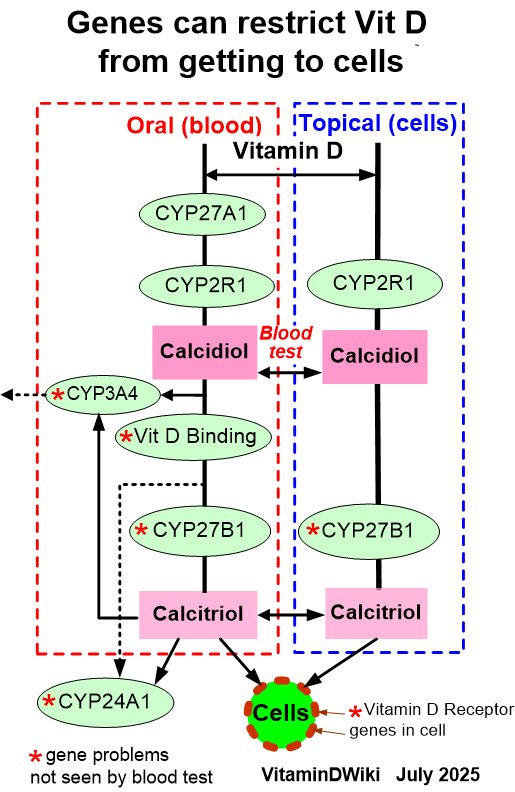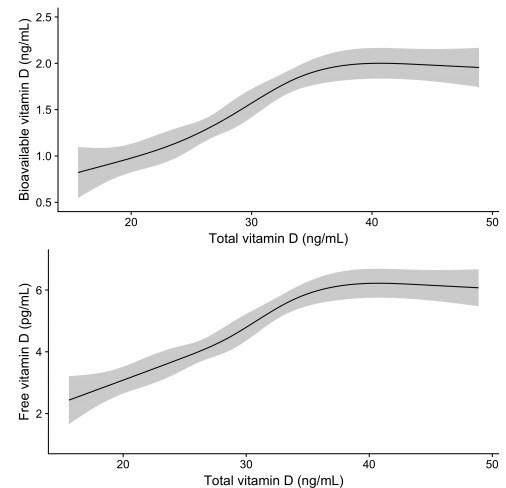Ulcerative Colitis (new) associated with lower free and bioavailable Vitamin D, but not total
Free and Bioavailable 25-Hydroxyvitamin D Concentrations are Associated With Disease Activity in Pediatric Patients With Newly Diagnosed Treatment Naïve Ulcerative Colitis.
Inflamm Bowel Dis. 2018 Feb 15;24(3):641-650. doi: 10.1093/ibd/izx052.
Sauer CG1, Loop MS2, Venkateswaran S1, Tangpricha V1, Ziegler TR1, Dhawan A3, McCall C4, Bonkowski E4, Mack DR5, Boyle B6, Griffiths AM7, Leleiko NS8, Keljo DJ9, Markowitz J10, Baker SS11, Rosh J12, Baldassano RN13, Davis S2, Patel S1, Wang J2, Marquis A2, Spada KL14, Kugathasan S1, Walters T7, Hyams JS14, Denson LA4.

📄 Download the PDF from VitaminDWiki
Higher levels of Free and Bio-available associated with less Colitis

Both Free and Bioavailable plateau about 40 ng total
Thus a total >40ng should be associated with less Colitis

BACKGROUND:
Vitamin D regulates intestinal epithelial and immune functions, and vitamin D receptor deficiency increases the severity of murine colitis. Bioavailable 25-hydroxyvitamin D (25(OH)D) is available to target tissues and may be a driver of immune function. The aim is to evaluate the relationship of bioavailable 25(OH)D to the clinical expression of treatment naive pediatric ulcerative colitis (UC).
METHODS:
The PROTECT (Predicting Response to Standardized Pediatric Colitis Therapy) study enrolled children ≤17 years newly diagnosed with UC. Free and total 25(OH)D were directly measured and 25(OH)D fractions were compared with disease activity measures.
RESULTS:
Data were available on 388 subjects, mean age 12.7 years, 49% female, 84% with extensive/pancolitis. The median (IQR) total 25(OH)D concentration was 28.5 (23.9, 34.8) ng/mL, and 57% of subjects demonstrated insufficient vitamin D status (25(OH)D < 30 ng/mL). We found no evidence of association between total 25(OH)D and disease activity. Regression models adjusted for age, sex, race, and ethnicity demonstrated that an increase from 25th to 75th percentile for bioavailable and free 25(OH)D were associated with a mean (95th CI) decrease in the Pediatric Ulcerative Colitis Activity Index (PUCAI) of -8.7 (-13.7, -3.6) and -3.1 (-5.0, -1.2), respectively. No associations were detected between 25(OH)D fractions and fecal calprotectin or Mayo endoscopy score.
CONCLUSIONS:
Vitamin D insufficiency is highly prevalent in children with newly diagnosed UC. We found associations of free and bioavailable, but not total 25(OH)D, with PUCAI. Bioavailable vitamin D may contribute to UC pathophysiology and clinical activity.
